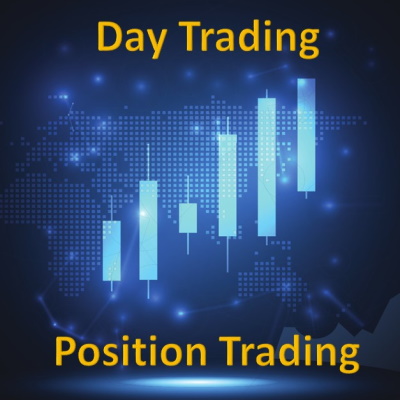Day Trading vs. Position Trading
Trying to decide between Forex day trading and Forex position trading? Learn more with Queensway before settling on your Forex strategy.

Day Trading vs. Position Trading – What’s the Difference?
If you’re just starting your trading journey, you might still be working on how to approach the market, which assets to focus on, and most importantly – which trading style to use. Among the most significant and popular with Forex traders are day trading and position trading.
To put it simply, the main difference between Forex day trading and Forex position trading is how long your trade is left open.
As the name implies, day traders usually buy and sell underlying assets within one day (one trading session), whereas position traders may leave their trades open for weeks or months, depending on the trend.
Most Forex trading platforms can be used for either style of trading, as well as sites that support stocks, commodities, indices, and currencies. Trying out either method can provide some of the best trading opportunities.
But, which one is better? There are constant debates and the answer depends on several factors.
Firstly, background and knowledge in trading the markets come into play.
Then, it all comes down to personal trading strategy, which is linked to time, energy and the amount of money available to trade with.
However, there are a few general pros and cons that apply to each method that traders should know before making their decision.
Time
This is obviously the biggest difference between the two trading styles. But it’s not just the amount of time a trade is held for; it’s also the amount of time spent choosing and monitoring trades.
Position trades are opened for longer periods, which means that they do not need to be closely monitor. This is because the trader aims at taking advantage of large price movements (riding a trend).
With day trades, one needs to be available to carefully follow the markets, as even small price changes are targeted. Therefore, the trader will have to spend more time screening the market and monitoring open positions.
Risks
The risk involved in Forex day trading and Forex position trading differs, but it is difficult to say that one is inherently higher or lower. Short terms trends are much less predictable than long term ones, after all.
To protect one’s capital, money and risk management tools like Stop Loss and Take Profit orders can help, especially for short-term trading.
Nonetheless, one ends up spending more time analysing the markets when investing during a trading session to be sure of short term movements, than when buying (or short-sell) and holding a position in order to ride a trend over the mid or long term.
 Emotions
Emotions
In addition to the risks associated with these market approaches, emotions and feelings are also important, as they will be stronger when one is forced to monitor positions over the short-term.
In this case, the consequence of emotions getting involved is much higher, as this trading technique is more stressful and energy-consuming. Traders face a wider range of emotions like fear, greed, panic and euphoria.
On the other hand, most day traders will invest relatively small amounts in every single trade and can hedge easily. Position traders have the disadvantage that comes with leaving open trades during times when they cannot be monitored, modified, or even closed (when sleeping, for instance).
Trading Opportunities
Day trading strategies offer more opportunities to take advantage of the market. Position trading strategies, on the other hand, offer fewer opportunities, as traders aim to keep positions open in hopes that they will appreciate in value over time.
Moreover, the money invested will be tied up for an unknown period of time, which means that the trader might not be able to take advantage of other upcoming trading opportunities.
Profits
Of course, what most traders want to know is which trading method makes more money. And of course, it is impossible to know.
The profits from each position trade can be much larger than each day trade, and traders spend a lot less time doing research and preparation to be a good position trader.
But with several positions open during a trading session, the overall profit can also be higher and much faster, putting an end to the trading day after a few minutes or hours of trading.
A Final Word:
It all Comes Down to your Personality. The most important thing to consider is to pick a trading strategy that matches your goals, availability, and most importantly, your psychological makeup.
Some traders use a combined approach, as they might have different financial goals. This way, they can enhance their performance by broadening the number of market opportunities they take advantage of.
In this case, intraday positions can be used to take advantage of short-term price fluctuations (day trader) within a major trend, which can also be traded by a position trader who has a directional bias in the long term.
Day Trading Strategies Might be Best if:
- You have time to trade the markets.
- You’re stress-resistant.
- You prefer to be in front of the screen during key moments (e.g. central banks’ interest rate decisions), so you can take strategic advantage of market opportunities.
- You want to stop your trading activity without having any positions overnight.
Position Trading Strategies Might be Best if:
- You do not have a lot of time to dedicate to trading.
- You do not like very stressful and emotional activities.
- You prefer to analyse the markets quietly in advance, to spot potential new trends, wait for them to occur, and hold positions for a while.




